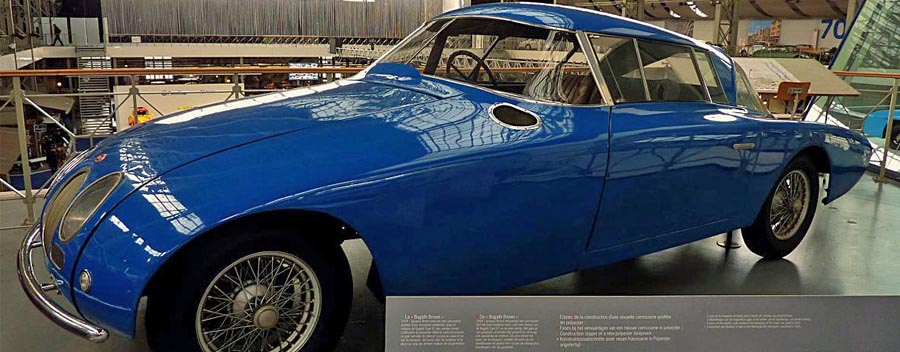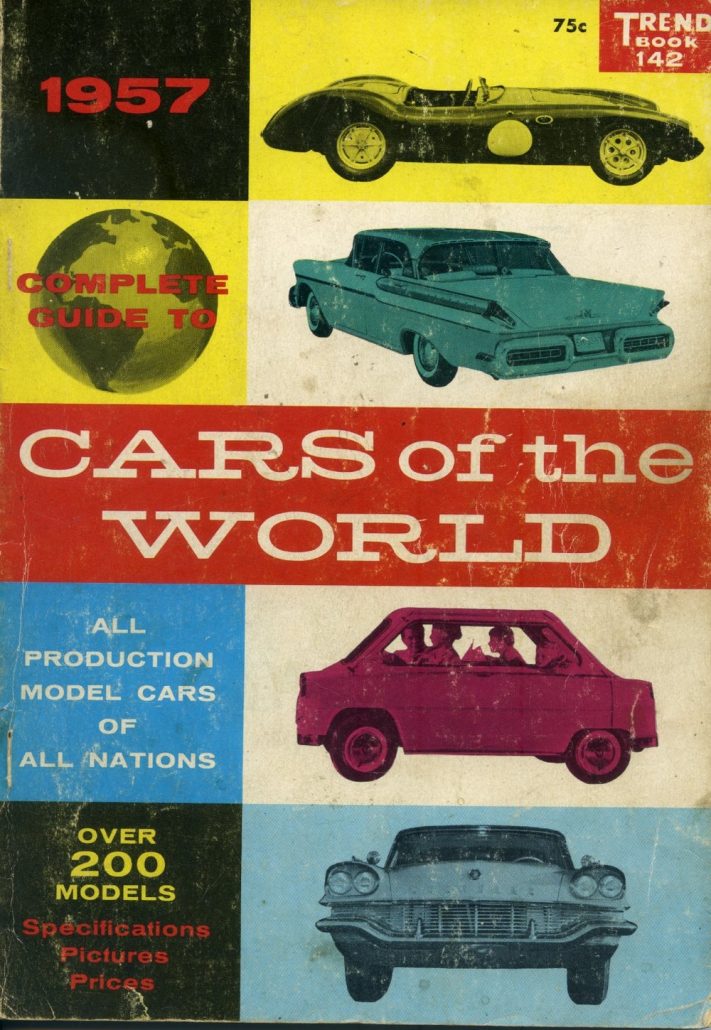
Hi Gang…
In the mid 1950s, the name Bugatti still evoked the greatness of its prewar years, and many a car enthusiast wanted to see this marque return to the forefront of design. A well-known French artist – James-Jacques Brown (born 1918 – click here to learn more about him – in French so you will have to translate) – took on this task and built two fiberglass-bodied sports cars on Bugatti 1930s T57 chassis in the mid 1950s.
Remember…in the mid 1950s, fiberglass was still the new wonder material and cars made from it were seen as special – just as carbon fiber cars are seen today. It was the perfect material for a sculptor such as Jame-Jacques Brown to use too.
I came across this interesting piece of information via good fiber-friend Paul Sable who clued me in on an interesting Trend book from 1957 called “Cars of the World.” Let’s see what this magazine had to say about this special-bodied Bugatti back in 1957.
France: Bugatti
Automobile Bugatti, Molsheim
Cars of the World: 1957 (Trend Book)
According to the latest information available, the Bugatti shown here is a special plastic body created by the James Brown firm, designed to modernize existing Bugatti chassis. The latest Bugatti built is the 101, available again this year as a convertible, two-door, or four-door sedan.
The 101 chassis is also available, so that you may attach your own individualized body to it. The Bugatti 101 uses a pressed-rail chassis of 129.5 wheelbase. The car features front suspension on semi-elliptic leaf springs, while the rear suspension uses quarter-elliptic springing.
The 101 has an inline, coil-ignition powerplant of eight cylinders. It is equipped with a dual downdraft carburetor and a supercharger. With a 199.57 cubic inch displacement and a compression ratio of 6.5 to 1, power output is rated at 190 bhp at 5400 rpm.
The engine has an overhead camshaft. The four-speed pre-select gearbox is also featured. Top speed is about 112 miles per hour. The car has a 12 volt electrical system, hydraulic brakes, and weighs 3748 pounds dry. According to factor information, a new Bugatti will be announced early in 1957. Unfortunately, information on this sports-model vehicle was not available as we went to press with this year’s edition of “World Cars.”
Additional Research:
After reading this information, I was curious if I could find out more about this car, and I was pleased to learn that the car still exists. Let’s check out some photos first, and then jump into the story posted on a website in Greece titled “Historic Automotive Promotion” which has more history about this Bugatti.
Bugatti T57 by James Brown
From: http://www.historicautopro.com/#!1952-bugatti-t57-by-james-brown/c9oy
This unique Bugatti from Mahy collection take place in Autoworld Museum Brussels.
This special creation is built on a pre-war chassis-type 57 by sculptor James Brown, the futuristic body for the time is fiberglass (as contemporary Corvette) and allows a reduction of 250 kg; the wheels are 16 inches instead of 18 inches.
The sculptor Jacques Brown rebodied the old T57 chassis in a more aerodynamic form using polyester for the body panels, thus saving weight and increasing performance. His vision was highly praised at the time, but probably not so by marque purists more than half a century later.
In 1955 shown on the Salon de l ‘Automobile in Paris. James Brown made two of them on a Bugatti T57 chassis (#57645 and #57723), hoping to get commissions for more.
Unfortunately for him there were no takers. The body remained on the T57 chassis (probably #57723) until the 1980s, but is now replaced with a VW floorpan.
James Jacques Brown is a French sculptor born in 1918 in Paris.He studied law and received a law degree from the École Libre des Sciences Politiques and became official at the Ministry of Finance from 1942 to 1945. At that time, he met Edith, who became his wife, they have three children: Frederick, Caroline and Thomas. After the Liberation, he began an artistic career.
In 1952, he participated in all of the Young Sculpture Shows,Salon de Mai in 1958, 1960, 1963, 1964 and 1965 and at the Salon Réalités Nouvelles .
In 1958 and 1959, Rodolphe Stadler Gallery in Paris organizes him two personal exhibitions. And the following year the Mayer Gallery in New York presented a set of his works.
He concludes his artistic activity in the late 1980s, before disappearing in 1991.
Summary:
So if James-Jacques Brown made two and we’ve located one….where’s the lost fiberglass Bugatti? Something for our European Forgotten Fiberglass devotees to uncover in a future issue for us to enjoy.
Hope you enjoyed the story, and remember gang…
The adventure continues here at Forgotten Fiberglass.
Geoff











car in museum has a US 1930’s chassis no engine
the 2nd car is in france awaiting restoration
Great story an pictures. I never knew VW built a Beetle with a wheelbase of 129.5 inches I would love to se a picture of the bellypan.. or better yet a picture of the shortened body to fit a stock bellypan.
Mel Keys
There have been some ‘stretch’ Bug limos made – the stock pan would be fairly easy to make longer. I have more of a problem with being rear engine with its styling.
Bob…It’s all posted underneath the color photos and accessible by clicking on the link just under the color photos. I took this information from the website (active link) I noted just under the last color photo. Hope this helps….Geoff
What is the location where these photos were taken? It looks like an auto museum or other special museum.
Auto world Brussel
The front is a pleasing design – would have looked good as a SAAB sports car. But the wheelbase is strange – It falls between the first Lincoln Continentals [125″] and a Duesenberg [135″] This makes it longer than Briggs Cunningham’s 1950 la Monster Cadillac with about 2/3s the engine size.
Yes, I am a Bugattiste, and I enjoyed this story very much. Very good photographs! Told some of my fellow Bugatti Buddies about it!
Vive la Marque,
Paul Hooft,
Netherlands
Glad you enjoyed the story Paul 🙂 Geoff
Very odd looking car, but when you compare it to the aerodynamics of a 1957 chevy, this one wins completely .
What a great looking special….ok…slightly wierd from some angles but wow!
Lest there be confusion among Bugatti lovers and others, this body was never on a 101 Bugatti chassis, nor was it even really connected to the famous Marque ( read the 1957 Trend story again, with some hindsight )
I well remember , there was lots of ‘creative ‘ writing by some wannabe kit car builders in the 50’s, and these Trend Books were full of exciting, but very misleading, stories about “what could be ” written as if it were real. Mentioning this body in a story, followed by the specifications of the new 101 chassis, was deception at it’s highest ( at that time)
In 1957, this story lead me to believe this 101 SuperCar from France might actually be seen at the NY auto show … but alas, it was just a “dreamers dream”, built on an old French Bug chassis , and misrepresented as it was, had no marketability.
Others did the same in the States through the 80’s, some with more integrity, others with even less… leaving a struggling kit car industry, nearly collapsing in the 80’s. Anyone with 20 gallons of resin made a mold and a body or two, then put out pictures and a story. Most of the time, the ‘cars’ were never even completed to drive. The same thing still happens occasionally.
Based on the deception presented in the Trend Book, this body got what it deserved…going from an old French Bug chassis…to a later lowly German VW Bug pan.
Maybe if Brown had originally put it on an appropriate Citroen C2v chassis, Brown might have become the French ‘Devin’.
might have, might have, might have ! beep beep .
Dave Perry OldSchool Restorations of North Alabama USA
Dave,
Nice informed comments. are you near wetumpka?
.
off I-65.. half way between Birmingham and Huntsville
Roll Tide
Great points here Dave 🙂 Thanks for sharing…
.
.
Keep on writing, Geoff… brings back lots of memories…
like my ’57 Mercury on the cover, … Dad also had one, it was my prom car in ’58 and 59
I guess I’m done dancing ( but not done racin’)…so I’ll probably sell my Merc too.